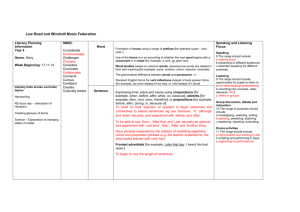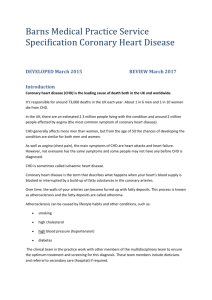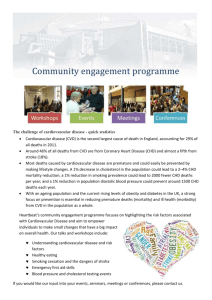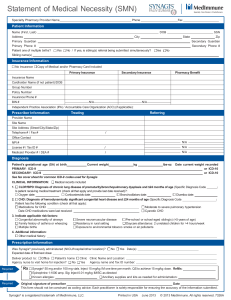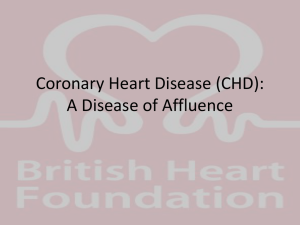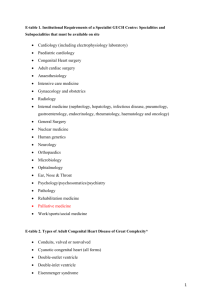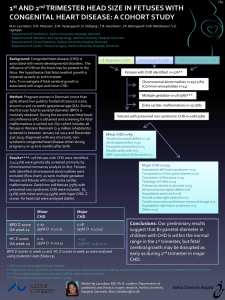CHD Surveillance April 14, 2015 1230
advertisement
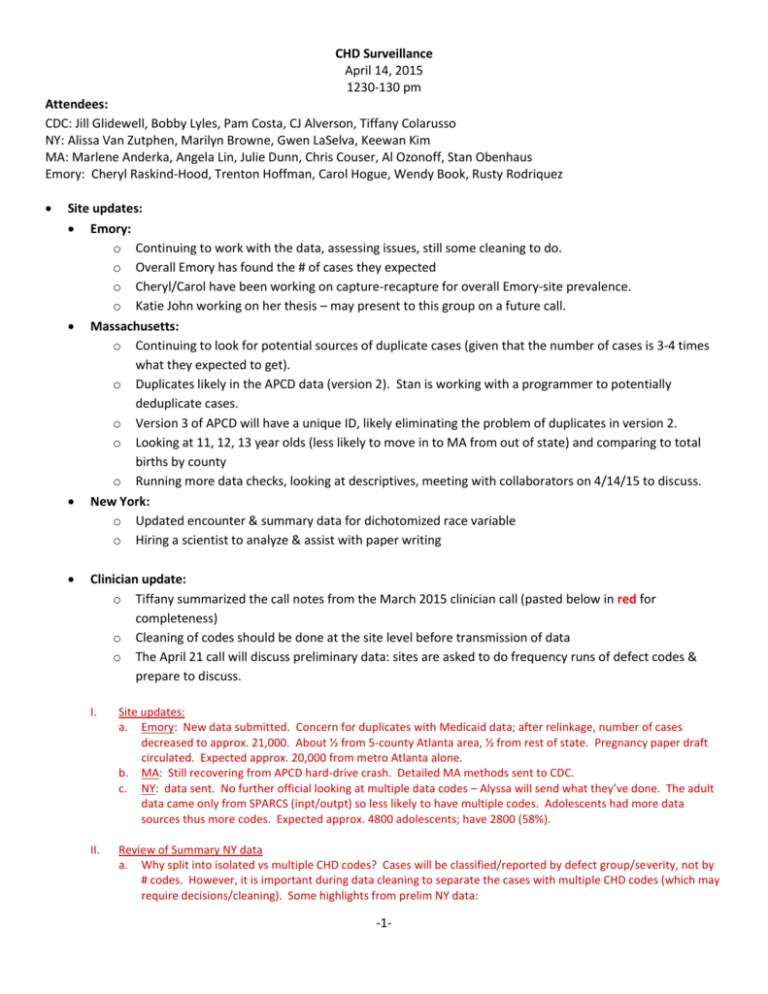
CHD Surveillance April 14, 2015 1230-130 pm Attendees: CDC: Jill Glidewell, Bobby Lyles, Pam Costa, CJ Alverson, Tiffany Colarusso NY: Alissa Van Zutphen, Marilyn Browne, Gwen LaSelva, Keewan Kim MA: Marlene Anderka, Angela Lin, Julie Dunn, Chris Couser, Al Ozonoff, Stan Obenhaus Emory: Cheryl Raskind-Hood, Trenton Hoffman, Carol Hogue, Wendy Book, Rusty Rodriquez Site updates: Emory: o Continuing to work with the data, assessing issues, still some cleaning to do. o Overall Emory has found the # of cases they expected o Cheryl/Carol have been working on capture-recapture for overall Emory-site prevalence. o Katie John working on her thesis – may present to this group on a future call. Massachusetts: o Continuing to look for potential sources of duplicate cases (given that the number of cases is 3-4 times what they expected to get). o Duplicates likely in the APCD data (version 2). Stan is working with a programmer to potentially deduplicate cases. o Version 3 of APCD will have a unique ID, likely eliminating the problem of duplicates in version 2. o Looking at 11, 12, 13 year olds (less likely to move in to MA from out of state) and comparing to total births by county o Running more data checks, looking at descriptives, meeting with collaborators on 4/14/15 to discuss. New York: o Updated encounter & summary data for dichotomized race variable o Hiring a scientist to analyze & assist with paper writing Clinician update: o Tiffany summarized the call notes from the March 2015 clinician call (pasted below in red for completeness) o Cleaning of codes should be done at the site level before transmission of data o The April 21 call will discuss preliminary data: sites are asked to do frequency runs of defect codes & prepare to discuss. I. Site updates: a. Emory: New data submitted. Concern for duplicates with Medicaid data; after relinkage, number of cases decreased to approx. 21,000. About ½ from 5-county Atlanta area, ½ from rest of state. Pregnancy paper draft circulated. Expected approx. 20,000 from metro Atlanta alone. b. MA: Still recovering from APCD hard-drive crash. Detailed MA methods sent to CDC. c. NY: data sent. No further official looking at multiple data codes – Alyssa will send what they’ve done. The adult data came only from SPARCS (inpt/outpt) so less likely to have multiple codes. Adolescents had more data sources thus more codes. Expected approx. 4800 adolescents; have 2800 (58%). II. Review of Summary NY data a. Why split into isolated vs multiple CHD codes? Cases will be classified/reported by defect group/severity, not by # codes. However, it is important during data cleaning to separate the cases with multiple CHD codes (which may require decisions/cleaning). Some highlights from prelim NY data: -1- b. III. IV. i. Adolescents(n=2806): 63% (1766) were isolated, 37% had >1 CHD code. Of those that were isolated, 92% (n= 1615) had non-severe CHD. 361 (20% of all isolated cases) had VSDs and 294 (17%) had ASDs ii. Adults (n=4432): 94% (4160) were isolated, 6% had >1 CHD code. Of those that were isolated, 98% (n=4067) had non-severe CHD. 2122 (51% of all isolated cases) had ASD and 210 (5%) had VSDs. Eventually will place and report cases in defect categories, but the data needs to be cleaned Diagnostic data cleaning discussion a. The NY cases with >1 CHD were not analyzed by defect, but it was noted that there were several instances of minor/secondary codes. Back in Sept 2014 and finalized in October 2014, it was agreed to ignore/exclude select minor/secondary/nonspecific defects if occurring with other codes. That is, only count if in isolation. These codes were denoted in subsequent spreadsheets and guidelines as having gray shadowed color. Thus, while all defects should be retained at the encounter level, for the summary record, if another CHD is present, these minor codes should be excluded and not appear. b. Discussed what to do if a case had >1 minor code and no major codes (e.g. AI + MR, or AI + nonspecific chd). This needs to be agreed on by all 3 sites. i. Exclude the non-specific codes in favor of more specific minor codes ii. Keep both minor codes in their respective categories iii. Review other clinical data (e.g. interventions) or count # times the code occurred to determine which would be the more significant CHD to keep. (e.g. AI+MR+ aortic valve replacement -> keep AI) c. Also need to exclude any case that only has fetal echo and no pregnancy codes or other encounter or procedure. Presumably if the case was truly a mother with chd getting a fetal echo on a baby, there would be other pregnancy codes. i. If no pregnancy codes and case has fetal echo, presume this is erroneously captured infant, not adolescent/adult. ii. Need to work on the exact criteria for this exclusion. Process for diagnostic data cleaning for the summary record. This needs to be agreed on by all 3 sites, with further discussion amongst the PI and data folks as to who will do the cleaning and to assure it is being done similarily across the sites. Please refer to the spreadsheet “code_category_map_Dec2014” in which the gray highlighted codes are the minor or nonspecific CHD codes, hereafter referred to as “minor”. This mapping has been discussed and agreed on in the past. a. Exclude cases with only fetal echo (specific criteria still need to be determined - see discussion above) b. Split remaining cases into isolated (only 1 CHD code) and multiples (>1 CHD code) c. For isolated: i. Apply the categories (see spreadsheet) to assign the diagnostic codes to the larger CHD categories (severe, valvar, shunt, valvar+shunt, Other). ii. The minor CHDs ARE counted if there is only 1 CHD. d. For the multiples: i. If a case has a ≥1 major CHD and ≥1 minor CHD: 1. Exclude the minor codes from Summary Record and only keep the major CHD. 2. This MAY result in a case having only 1 major CHD, in which case it can be considered an “isolated”. 3. All diagnostic codes are retained in encounter level data ii. If a case has >1 minor CHD only (no major CHDs), then 1. Need a frequency list of combinations 2. Clinicians will need to review and decide how to assign the cases (see discussion above) iii. Apply the categories (see spreadsheet) to assign the diagnostic codes to the larger CHD categories (severe, valvar, shunt, valvar+shunt, Other). This has been discussed and agreed on in the past. 1. If a case has a severe CHD, regardless of the presence of other CHDs, the case is counted ONLY in the severe category. 2. If a case has only non-severe CHDs (i.e., any other category), case is counted in all the categories. iv. Create list of code frequency combinations for review if needed e. Issues that may arise. Need to review and clean the diagnostic codes. -2- i. Noted in the NY data, there may be times where two codes may mean the same thing – e.g. 745.1 and 745.10 can only mean Truncus arteriosus. Same with 7456 and 74560. However, 7451 and 74510 do NOT mean the same thing (7451 is a broad category of all TGA but 74510 only refers to d-TGA type). ii. Similar codes may be grouped together. E.g. 756.6 (AVSD unspecified) and 745.69 (AVSD, Other) could be combined. These decisions will be discussed further and agreed on by all. V. CCS code mapping: See “MASTER_DXREF_Rev15”. This was a cross-walk created by Emory for ICD-9-CM -> CCS -> CDC database. Please review. Anything that is “blank” for the CDC database columns will NOT be included in this project data. VI. Maternal death: a. Cause of death is known from death certificate, but many cases can’t identify cause of death b/c no death certificate. For pregnant women who die, can’t know if the death is cardiac related or obstetric related. Bobby will add a box in summary record for “maternal death, NOS” VII. a. b. VIII. a. b. c. IX. a. b. c. d. e. f. g. h. Clinical section of methods paper: Ami and Michelle have commented/edited. Other clinicians need to edit/comment. Need all sites to document the sampling results done early in the study – table is filled in with Emory data only Guidelines for high-risk OB care: Discussed whether there were guidelines or practice for referring women with CHD to MFM (define as a high risk pregnancy on basis of maternal CHD). No specific US guidelines are known, although data exists from other countries. European Society of Cardiology has guidelines which are followed here in US. Clinicians will circulate amongst us the papers/guidance that clarifies this issue. TO DO: Tiffany will circulate the table of our code groupings alongside the Marelli ones Sites need to discuss diagnostic data cleaning George Lui and others to comment on the criteria for excluding cases with only a fetal echo. George will also start compiling procedure codes that align with the minor CHDs, for potential use in dealing with cases that have multiple minor codes and no major codes. All will review the CCS maping All will review/revise the clinician methods section Bobby will add another box for maternal cause of death to database. Circulate papers/guidance on pregnancy care if available. Review/Discussion of demographic data: o Sites presented demographic data (below) and discussed similarities/differences between sites. Demographic characteristics of adolescents and adults with congenital heart defects (CHD) in NY, 2008-2010 Adolescents N Total Data sources Age (years) b % 2780 Clinic data base Adults N % 4432 2563 92.19 − − SPARCS Inpatient 281 10.11 3413 77.01 SPARCS Outpatient 329 11.83 1313 29.63 CMR a 710 25.54 − − 10 - 17 2038 73.31 − − 18 - 20 742 26.69 − − Adolescents c -3- Adults d Sex 20 - 30 − − 471 10.63 31 - 40 − − 458 10.33 41 - 50 − − 716 16.16 51 - 64 − − 1143 25.79 65+ − − 1644 37.09 Male 1270 45.68 2042 46.07 Female 1057 38.02 2390 53.93 453 16.29 − − 1184 42.59 4332 97.74 12 0.43 100 2.26 1584 56.98 − − Unknown − − − − American Indian/ Alaskan Native 4 0.14 14 0.32 Asian 23 0.83 45 1.02 Black 280 10.07 586 13.22 2 0.07 1 0.02 822 29.57 3137 70.78 1379 49.60 16 0.36 Unknown 275 9.89 633 14.28 Hispanic 345 12.41 558 12.59 Non-Hispanic 846 30.43 3788 85.47 1406 50.58 − − 183 6.58 86 1.94 28 1.01 171 3.86 1703 61.26 2415 54.49 Medicaid 278 10.00 354 7.99 Medicare 3 0.11 1447 32.65 96 3.45 45 1.02 672 24.17 − − − − − − Unavailable Vital status Living Deceased Unavailable Race e Native Hawaiian/ Pacific Islander White Unavailable Ethnicity Unavailable Unknown Insurance status Self pay Private Other, specified Unavailable Unknown a Only cases identified in clinic and SPARCS data bases were matched to CMR to obtain birth-related information; CMR is not a data source. b Calculated as of 1/1/2010. c Includes 113 cases of age 10, because we identified cases by birth year initially, whereas we calculated age as of 1/1/2010 afterwards. d Includes 22 cases of age 20, because we identified cases by birth year initially, whereas we calculated age as of 1/1/2010 afterwards. e Includes 5 multirace cases. CMR, Congenital Malformations Registry; SPARCS, Statewide Planning and Research Cooperative System. -4- Emory Site SUMMARY TABLES: Number of index cases / records transferred: Adolescents Adults (11-20)* (21-64)* TOTAL Tables S_CASE_SUMMARY 8273 12638 20911 S_CHD_DIAGNOSIS 8273 12638 20911 S_OTHERMEDCONDITIONS 5419 9269 14688 S_PROCEDURES 6246 5329 11575 * as of 1/1/2010 DEMOGRAPHICS agegrp Frequency Percent ƒƒƒƒƒƒƒƒƒƒƒƒƒƒƒƒƒƒƒƒƒƒƒƒƒƒƒƒƒƒƒƒ 11-20 8273 39.56 Adolescents 21-30 4353 20.82 Adults 31-40 3048 14.58 41-50 1957 9.36 51-60 2310 11.05 61-64 970 4.64 TOTAL n=12638 (60.44%) 20911 100.00% Mean Age N Mean Std Dev Std Err Minimum Maximum Overall 20911 29.7656 15.5916 0.1078 11.0000 64.0000 Adults 12638 39.1561 13.2229 0.1176 21.0000 64.0000 Adolescents 8273 15.4205 2.6197 0.0288 11.0000 20.0000 Vital Status Frequency Percent Sex Frequency Percent -5- ƒƒƒƒƒƒƒƒƒƒƒƒƒƒƒƒƒƒƒƒƒƒƒƒƒƒƒƒƒƒƒƒƒ ƒƒƒƒƒƒƒƒƒƒƒƒƒƒƒƒƒƒƒƒƒƒƒƒƒƒƒƒƒƒƒƒƒƒ Living Male 9829 Female 11082 19170 Deceased 91.67 1741 Race 8.33 Frequency 47.00 53.00 Percent ƒƒƒƒƒƒƒƒƒƒƒƒƒƒƒƒƒƒƒƒƒƒƒƒƒƒƒƒƒƒƒƒ White 6349 41.06 Black 3928 25.41 Other 5184 33.53 . 5450 26% Ethnicity Frequency Percent Primary Language Frequency Percent ƒƒƒƒƒƒƒƒƒƒƒƒƒƒƒƒƒƒƒƒƒƒƒƒƒƒƒƒƒƒƒƒƒƒƒƒƒƒ ƒƒƒƒƒƒƒƒƒƒƒƒƒƒƒƒƒƒƒƒƒƒƒƒƒƒƒƒƒƒƒƒƒƒƒƒƒƒƒ Hispanic 288 1.62 English 4462 84 Non-Hispanic 7797 43.94 Spanish Unknown 9659 54.44 Other, Specify 82.37 1.55 31 0.57 Unavailable . 3167 15% Unknown 28 812 0.52 . Residency Frequency 15494 50 Known to be in state, out of catchment* area Residing in catchment area . 10707 *catchment area: Clayton, Cobb, DeKalb, Fulton, 0.24 9842 Gwinnett 47.78 51.98 312 Dbs/ data sources Frequency 74% Percent ƒƒƒƒƒƒƒƒƒƒƒƒƒƒƒƒƒƒƒƒƒƒƒƒƒƒƒƒƒƒƒƒƒƒƒƒƒƒƒƒƒƒƒƒƒƒƒƒƒƒƒƒƒƒƒƒƒƒƒƒƒƒƒƒƒƒƒƒ Known to be out of state/country 14.99 Percent -6- SIBLEY 4573 CHOA 1220 PCS 68 21.87 5.83 Adolescents (Clinical & Billing) 0.33 EMORY 5418 25.91 GRADY 357 1.71 Adults ST JOE’S 438 2.09 MCAID 6704 32.06 Administrative MACDP 5271 25.21 Registry (Clinical & Billing) 89%% seen in 1 db; 11% seen in more than 1 db Count Count of ID % 1 18575 88.8% 2 1711 8.2% 3 471 2.3% 4 131 0.6% 5 23 0.1% 20911 100.0% -7- Vital Status VitalStatus Col Pct ‚No adolescent ‚Yes ‚ Total ƒƒƒƒƒƒƒƒƒˆƒƒƒƒƒƒƒƒˆƒƒƒƒƒƒƒƒˆ Living ‚ 11252 ‚ 7918 ‚ 19170 ‚ 53.81 ‚ 37.87 ‚ 91.67 ‚ 58.70 ‚ 41.30 ‚ ‚ 89.03 ‚ 95.71 ‚ ƒƒƒƒƒƒƒƒƒˆƒƒƒƒƒƒƒƒˆƒƒƒƒƒƒƒƒˆ Deceased ‚ 1386 ‚ 355 ‚ 1741 ‚ 6.63 ‚ 1.70 ‚ 8.33 ‚ 79.61 ‚ 20.39 ‚ ‚ 10.97 ‚ 4.29 ‚ ƒƒƒƒƒƒƒƒƒˆƒƒƒƒƒƒƒƒˆƒƒƒƒƒƒƒƒˆ Total 12638 8273 20911 60.44 39.56 100.00 Statistic DF Value Prob ƒƒƒƒƒƒƒƒƒƒƒƒƒƒƒƒƒƒƒƒƒƒƒƒƒƒƒƒƒƒƒƒƒƒƒƒƒƒƒƒƒƒƒƒƒƒƒƒƒƒƒƒƒƒ Chi-Square 1 291.9507 <.0001 Sex Sex adolescent Col Pct ‚No ‚Yes ‚ Total ƒƒƒƒƒƒƒƒƒˆƒƒƒƒƒƒƒƒˆƒƒƒƒƒƒƒƒˆ Male ‚ 5350 ‚ 4479 ‚ 9829 ‚ 25.58 ‚ 21.42 ‚ 47.00 ‚ 54.43 ‚ 45.57 ‚ ‚ 42.33 ‚ 54.14 ‚ ƒƒƒƒƒƒƒƒƒˆƒƒƒƒƒƒƒƒˆƒƒƒƒƒƒƒƒˆ Female ‚ 7288 ‚ 3794 ‚ 11082 ‚ 34.85 ‚ 18.14 ‚ 53.00 -8- ‚ 65.76 ‚ 34.24 ‚ ‚ 57.67 ‚ 45.86 ‚ ƒƒƒƒƒƒƒƒƒˆƒƒƒƒƒƒƒƒˆƒƒƒƒƒƒƒƒˆ Total 12638 8273 20911 60.44 39.56 100.00 Statistic DF Value Prob ƒƒƒƒƒƒƒƒƒƒƒƒƒƒƒƒƒƒƒƒƒƒƒƒƒƒƒƒƒƒƒƒƒƒƒƒƒƒƒƒƒƒƒƒƒƒƒƒƒƒƒƒƒƒ Chi-Square 1 279.8284 <.0001 Race adolescents Frequency‚ Col Pct ‚ 0‚ 1‚ Total ƒƒƒƒƒƒƒƒƒˆƒƒƒƒƒƒƒƒˆƒƒƒƒƒƒƒƒˆ . ‚ 1794 ‚ 3656 ‚ . ƒƒƒƒƒƒƒƒƒˆƒƒƒƒƒƒƒƒˆƒƒƒƒƒƒƒƒˆ 1 ‚ 4764 ‚ 1585 ‚ 6349 white ‚ 30.81 ‚ 10.25 ‚ 41.06 ‚ 75.04 ‚ 24.96 ‚ ‚ 43.93 ‚ 34.33 ‚ ƒƒƒƒƒƒƒƒƒˆƒƒƒƒƒƒƒƒˆƒƒƒƒƒƒƒƒˆ 2 ‚ 2861 ‚ 1067 ‚ 3928 black ‚ 18.50 ‚ 6.90 ‚ 25.41 ‚ 72.84 ‚ 27.16 ‚ ‚ 26.38 ‚ 23.11 ‚ ƒƒƒƒƒƒƒƒƒˆƒƒƒƒƒƒƒƒˆƒƒƒƒƒƒƒƒˆ 3 ‚ 3219 ‚ 1965 ‚ 5184 ‚ 20.82 ‚ 12.71 ‚ 33.53 Other ‚ 62.09 ‚ 37.91 ‚ ‚ 29.68 ‚ 42.56 ‚ ƒƒƒƒƒƒƒƒƒˆƒƒƒƒƒƒƒƒˆƒƒƒƒƒƒƒƒˆ Total 10844 4617 15461 70.14 29.86 100.00 -9- Frequency Missing = 5450 Statistic DF Chi-Square Value Prob 2 246.4746 <.0001 Effective Sample Size = 15461 Frequency Missing = 5450 WARNING: 26% of the data are missing. Ethnicity Ethnicity adolescent Col Pct ‚No ‚Yes ‚ Total ƒƒƒƒƒƒƒƒƒƒƒƒƒˆƒƒƒƒƒƒƒƒˆƒƒƒƒƒƒƒƒˆ . ‚ 608 ‚ 2559 ‚ . ƒƒƒƒƒƒƒƒƒƒƒƒƒˆƒƒƒƒƒƒƒƒˆƒƒƒƒƒƒƒƒˆ Hispanic ‚ 122 ‚ 166 ‚ 288 ‚ 0.69 ‚ 0.94 ‚ 1.62 ‚ 42.36 ‚ 57.64 ‚ ‚ 1.01 ‚ 2.91 ‚ ƒƒƒƒƒƒƒƒƒƒƒƒƒˆƒƒƒƒƒƒƒƒˆƒƒƒƒƒƒƒƒˆ Non-Hispanic ‚ 5379 ‚ 2418 ‚ 7797 ‚ 30.31 ‚ 13.63 ‚ 43.94 ‚ 68.99 ‚ 31.01 ‚ ‚ 44.71 ‚ 42.32 ‚ ƒƒƒƒƒƒƒƒƒƒƒƒƒˆƒƒƒƒƒƒƒƒˆƒƒƒƒƒƒƒƒˆ Unknown ‚ 6529 ‚ 3130 ‚ 9659 ‚ 36.80 ‚ 17.64 ‚ 54.44 ‚ 67.59 ‚ 32.41 ‚ ‚ 54.27 ‚ 54.78 ‚ ƒƒƒƒƒƒƒƒƒƒƒƒƒˆƒƒƒƒƒƒƒƒˆƒƒƒƒƒƒƒƒˆ Total 12030 5714 17744 67.80 32.20 100.00 -10- Frequency Missing = 3167 Statistic DF Chi-Square Value 2 Prob 90.5930 <.0001 Massachusetts Descriptive Statistics, CHD Surveillance Data Freque Percen Source ncy t s: APCD, Provide r Instituti ons, Vital Record s AgeGr p 10-19 20-29 30-39 40-49 50-59 60-69 70-79 80-89 90+ Total 13929 9829 8976 11792 12681 9688 6745 5092 1245 79977 17.42 12.29 11.22 14.74 15.86 12.11 8.43 6.37 1.56 100.00 Primary Language adolescent Col Pct ‚No ‚Yes ‚ Total ƒƒƒƒƒƒƒƒƒƒƒƒƒƒƒˆƒƒƒƒƒƒƒƒˆƒƒƒƒƒƒƒƒˆ . ‚ 8383 ‚ 7111 ‚ . ƒƒƒƒƒƒƒƒƒƒƒƒƒƒƒˆƒƒƒƒƒƒƒƒˆƒƒƒƒƒƒƒƒˆ English ‚ 3544 ‚ 918 ‚ 4462 ‚ 65.42 ‚ 16.95 ‚ 82.37 ‚ 79.43 ‚ 20.57 ‚ ‚ 83.29 ‚ 79.00 ‚ ƒƒƒƒƒƒƒƒƒƒƒƒƒƒƒˆƒƒƒƒƒƒƒƒˆƒƒƒƒƒƒƒƒˆ -11- Spanish ‚ 56 ‚ 28 ‚ 84 ‚ 1.03 ‚ 0.52 ‚ 1.55 ‚ 66.67 ‚ 33.33 ‚ ‚ 1.32 ‚ 2.41 ‚ ƒƒƒƒƒƒƒƒƒƒƒƒƒƒƒˆƒƒƒƒƒƒƒƒˆƒƒƒƒƒƒƒƒˆ Other, Specify ‚ 28 ‚ 3‚ 31 ‚ 0.52 ‚ 0.06 ‚ 0.57 ‚ 90.32 ‚ 9.68 ‚ ‚ 0.66 ‚ 0.26 ‚ ƒƒƒƒƒƒƒƒƒƒƒƒƒƒƒˆƒƒƒƒƒƒƒƒˆƒƒƒƒƒƒƒƒˆ Unavailable ‚ 603 ‚ 209 ‚ 812 ‚ 11.13 ‚ 3.86 ‚ 14.99 ‚ 74.26 ‚ 25.74 ‚ ‚ 14.17 ‚ 17.99 ‚ ƒƒƒƒƒƒƒƒƒƒƒƒƒƒƒˆƒƒƒƒƒƒƒƒˆƒƒƒƒƒƒƒƒˆ Unknown ‚ 24 ‚ 4‚ 28 ‚ 0.44 ‚ 0.07 ‚ 0.52 ‚ 85.71 ‚ 14.29 ‚ ‚ 0.56 ‚ 0.34 ‚ ƒƒƒƒƒƒƒƒƒƒƒƒƒƒƒˆƒƒƒƒƒƒƒƒˆƒƒƒƒƒƒƒƒˆ Total 4255 1162 5417 78.55 21.45 100.00 Frequency Missing = 15494 Statistic DF Chi-Square Value 4 Prob 21.3408 0.0003 Residency Residency Col Pct adolescent ‚No ‚Yes ‚ Total ƒƒƒƒƒƒƒƒƒƒƒƒƒƒƒƒƒˆƒƒƒƒƒƒƒƒˆƒƒƒƒƒƒƒƒˆ . ‚ 127 ‚ 185 ‚ . -12- ƒƒƒƒƒƒƒƒƒƒƒƒƒƒƒƒƒˆƒƒƒƒƒƒƒƒˆƒƒƒƒƒƒƒƒˆ Known to be out ‚ 49 ‚ 1‚ 50 of state/country ‚ 0.24 ‚ 0.00 ‚ 0.24 ‚ 98.00 ‚ 2.00 ‚ ‚ 0.39 ‚ 0.01 ‚ ƒƒƒƒƒƒƒƒƒƒƒƒƒƒƒƒƒˆƒƒƒƒƒƒƒƒˆƒƒƒƒƒƒƒƒˆ Known to be in ‚ 5664 ‚ 4178 ‚ 9842 state, out of ‚ 27.50 ‚ 20.28 ‚ 47.78 catchment area ‚ 57.55 ‚ 42.45 ‚ ‚ 45.27 ‚ 51.66 ‚ ƒƒƒƒƒƒƒƒƒƒƒƒƒƒƒƒƒˆƒƒƒƒƒƒƒƒˆƒƒƒƒƒƒƒƒˆ Residing in ‚ 6798 ‚ 3909 ‚ 10707 catchment area ‚ 33.00 ‚ 18.98 ‚ 51.98 ‚ 63.49 ‚ 36.51 ‚ ‚ 54.34 ‚ 48.33 ‚ ƒƒƒƒƒƒƒƒƒƒƒƒƒƒƒƒƒˆƒƒƒƒƒƒƒƒˆƒƒƒƒƒƒƒƒˆ Total 12511 8088 20599 60.74 39.26 100.00 Frequency Missing = 312 Statistic Chi-Square DF Value Prob 2 105.1077 <.0001 Upcoming calls: Clinician call – 4/21/15, 12:30-1:30pm Data call – 4/16/15, 12:30-1:30pm Joint call – 5/12/15, 12:30-1:30pm -13- Appendix: New York data transmission summary from 3/2/15 Number of index cases transferred: Tables Adolescents Adults S_CASE_SUMMARY 2780 4432 S_CHD_DIAGNOSIS 2780 4432 S_OTHERMEDCONDITIONS 1251 4386 S_PROCEDURES 2721 3953 Comments 1. S_CASE_SUMMARY - We left RecNum, SeqNum, DataSource, CodingSystem, DateOfDataSource, EncounterType, EncounterTypeOther, LengthOfStay as blank. - We reconciled inconsistent/multiple information on the demographic variables across data sources. 1) Sex: corrected based on the first name. 2) Race and ethnicity: reconciled based on the most frequent race appeared on the encounter-level records of an index case; if frequencies were same from each data source, we transferred race appeared on the clinic or SPARCS inpatient data. 3) County: we transferred county code from the most recent encounter-level record of an index case. 4) Insurance status: for index cases with more than 2 insurance information, we transferred insurance status from their most recent encounter-level record. 5) Number of cases with inconsistent/multiple information on the demographic variables across data sources Adolescents Adults Sex 9 Race 14 8 Ethnicity 26 25 County 11 12 Insurance 118 118 2. S_ OTHERMEDCONDITIONS - Due to index cases with more than 25 comorbidity codes, we assigned SeqNum from 1 to 3 depending on the total number of comorbidity codes per index case. 3. S_PROCEDURES - Due to index cases with more than 25 procedure codes, we assigned SeqNum from 1 to 3 depending on the total number of procedure codes per index case. - We left CodingSystem as blank because of mixture of ICD-9-CM and CPT codes within the summary record of an index case. -14-

